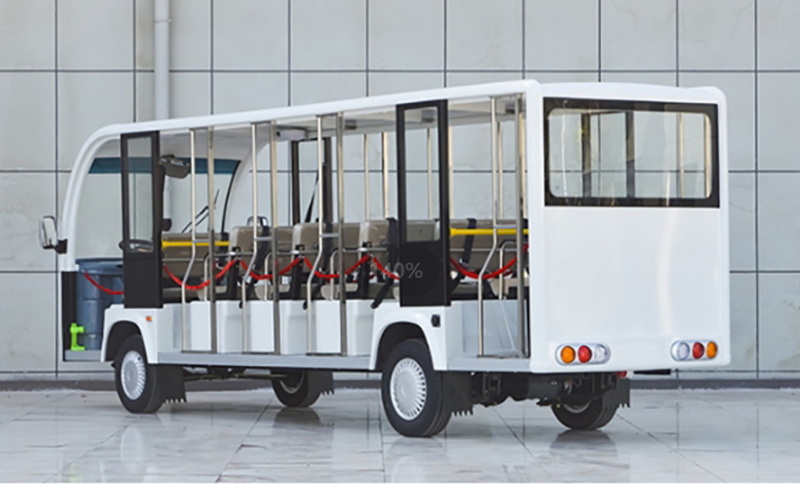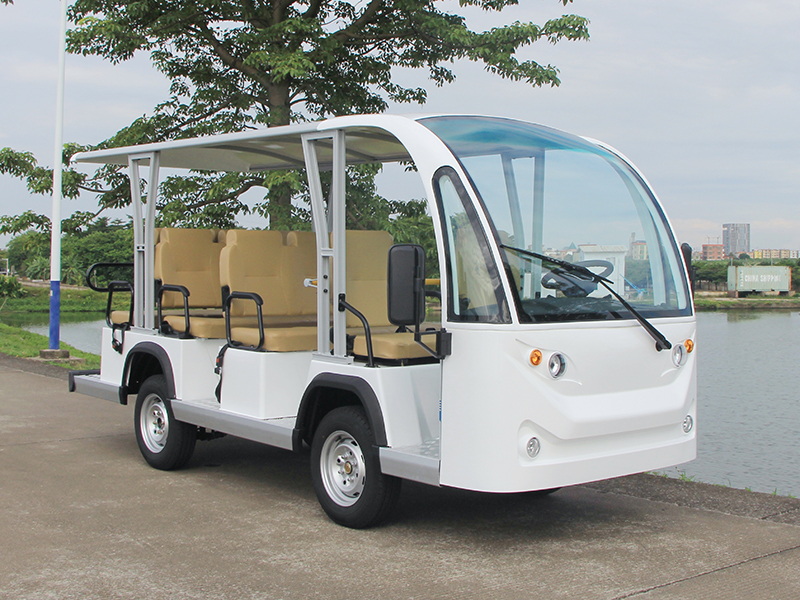Content Menu
● Introduction to Personalized Electric Tourist Buses
● Key Features of Personalized Electric Tourist Buses
>> 1. Powertrain and Battery Options
>> 2. Comfortable Seating and Interior Design
>> 3. Safety Features
>> 4. Weather Protection and Customizable Enclosures
>> 5. Exterior and Aesthetic Customization
>> 6. Eco-Friendly and Energy-Saving Features
>> 7. Advanced Suspension and Ride Quality
>> 8. Technological Enhancements
>> 9. Capacity and Size Variations
>> 10. Multimedia and Connectivity
● Conclusion
● FAQ
>> 1. What is the typical range of a personalized electric tourist bus?
>> 2. Can the seating capacity of a personalized electric tourist bus be customized?
>> 3. What safety features are included in these buses?
>> 4. Are there options for weather protection on personalized electric tourist buses?
>> 5. How is the environmental impact of these buses minimized?
Electric tourist buses are becoming increasingly popular worldwide due to their environmental benefits, quiet operation, and cost efficiency. A personalized electric tourist bus takes this concept further by tailoring the vehicle to meet specific customer needs, enhancing passenger comfort, safety, and overall experience. This article explores a wide range of features that can be added to a personalized electric tourist bus, supported by detailed descriptions and explanations to illustrate these innovations.

Introduction to Personalized Electric Tourist Buses
A personalized electric tourist bus is an electric-powered vehicle designed specifically for sightseeing and tourist transportation, customized to suit the requirements of operators and passengers. These buses typically range from 8 to 23 seats and are equipped with advanced electric drivetrains, smart steering, and safety systems. They provide a sustainable alternative to traditional fossil fuel buses, reducing emissions and noise pollution in tourist areas.
The rising demand for eco-friendly tourism transportation has driven manufacturers to develop buses that not only run on clean energy but also offer customizable features to enhance the passenger experience. Personalization allows operators to tailor buses to specific routes, climates, and passenger demographics, making each vehicle unique and optimized for its intended use.
Key Features of Personalized Electric Tourist Buses
1. Powertrain and Battery Options
Personalized electric tourist buses offer various battery and motor configurations to match range and performance needs:
- Battery Types: Lithium-ion batteries with capacities ranging from 72V 200AH to 96V 400AH provide driving ranges from 80 km to 240 km when fully loaded. These batteries are lightweight, have high energy density, and support fast charging.
- Motor Power: AC motors with power outputs from 7.5KW to 15KW ensure smooth and efficient driving, capable of handling different terrains and passenger loads.
- Charging Systems: Onboard chargers with different amperage ratings (e.g., 72V 20A, 96V 12A) support rapid and convenient charging. Some buses also support fast charging stations, reducing downtime during tours.
The choice of powertrain components can be customized based on the expected daily mileage, terrain, and charging infrastructure availability, allowing operators to optimize operational costs and efficiency.
2. Comfortable Seating and Interior Design
Passenger comfort is a top priority in personalized electric tourist buses:
- Ergonomic Seats: Seats are designed to provide maximum comfort during long sightseeing tours. They often feature cushioning, adjustable backrests, and armrests. Seat belts can be installed optionally for enhanced safety.
- Panoramic Windows: Large, clear windows provide unobstructed views, allowing passengers to enjoy scenic routes fully. The windows are often tinted to reduce glare and heat.
- Climate Control: Air conditioning units and cabin fans maintain a comfortable interior temperature regardless of external weather conditions. Some models include heating systems for colder climates.
- Sound Systems: Integrated audio systems with high-quality speakers enable guided tours, music playback, or announcements, enriching the passenger experience.
The interior layout can be personalized with different seat configurations, color schemes, and materials to match the brand or theme of the tour operator.
3. Safety Features
Safety is paramount in any passenger vehicle, and personalized electric tourist buses come equipped with multiple safety systems:
- Braking Systems: Four-wheel hydraulic braking systems combined with independent parking brakes ensure reliable and responsive stopping power.
- Smart Steering: Rack and pinion or smart steering systems enable a small turning radius (around 6.5 meters), making the bus easy to maneuver in narrow streets and crowded tourist areas.
- Seatbelts: Optional seatbelt installation increases passenger safety during transit, especially on routes with uneven terrain.
- Advanced Electronic Safety Aids: Some models, such as the Yutong U11DD, include Electronic Braking System (EBS), Electronic Stability Program (ESP), and Hill Start Assist (HSA), which help maintain control during emergency braking, slippery conditions, and hill starts.
Additionally, buses can be fitted with cameras and sensors to assist drivers with blind spots and parking, further enhancing safety.
4. Weather Protection and Customizable Enclosures
Tourist buses often operate in varying weather conditions, so weather protection features are essential:
- Full Enclosure Weather Curtains: These transparent curtains protect passengers from rain, wind, and dust while maintaining visibility. They can be rolled up or removed in good weather.
- Sun Shade Curtains: Installed inside the bus, these curtains help block excessive sunlight, reducing heat buildup and glare.
- Roof Materials: Aluminum frames with fiberglass covers provide durable, lightweight protection from rain and sun, ensuring longevity and low maintenance.
Some buses offer modular enclosure systems that can be adapted seasonally or according to passenger preferences, allowing flexibility in different climates.
5. Exterior and Aesthetic Customization
The exterior appearance of a personalized electric tourist bus can be tailored extensively:
- Body Materials: Rustproof metal steel bodies ensure durability and reduce maintenance costs in harsh environments.
- Color and Design: Operators can choose from a wide range of colors and custom paint jobs to match branding, themes, or local culture.
- Lighting: Full lighting systems including LED headlamps, tail lamps, and interior lights improve visibility and safety during night tours or low-light conditions.
Exterior customization also includes options for decals, logos, and decorative elements that make the bus stand out and attract tourists.

6. Eco-Friendly and Energy-Saving Features
Personalized electric tourist buses are designed to minimize environmental impact:
- Solar Panels: Optional solar panels can be installed on the roof to provide supplementary power for onboard electronics or auxiliary systems, reducing battery drain.
- Energy-Efficient Motors: High-performance AC motors reduce electricity consumption and extend battery life.
- Low Noise Operation: Electric drivetrains operate quietly, enhancing the tourist experience and reducing noise pollution in sensitive natural or urban areas.
Some buses also incorporate regenerative braking systems that recover energy during deceleration, further improving efficiency.
7. Advanced Suspension and Ride Quality
Passenger comfort is enhanced by sophisticated suspension systems:
- Macpherson Strut Suspension: This type of suspension provides excellent shock absorption, smoothing out bumps and uneven road surfaces.
- Ground Clearance: Adjustable or optimized ground clearance (typically around 100-130 mm) allows buses to navigate different road conditions safely, from smooth city streets to rural paths.
Good suspension and ride quality are critical for passenger satisfaction, especially on longer tours or routes with variable terrain.
8. Technological Enhancements
Modern personalized electric tourist buses integrate advanced technology to improve operation and passenger experience:
- Dashboard Instruments: Comprehensive dashboards include speedometers, battery indicators, voltmeters, and current meters, giving drivers real-time information to optimize driving and battery management.
- Smart Charging Management: Some buses support fast charging at depots or dedicated stations, minimizing downtime and maximizing operational efficiency.
- Maintenance Alerts: Onboard diagnostic systems notify operators of maintenance needs, helping prevent breakdowns and reduce repair costs.
- GPS and Navigation: Integrated GPS systems assist drivers with route planning and real-time navigation, improving punctuality and route efficiency.
9. Capacity and Size Variations
Personalized electric tourist buses can be tailored to different passenger capacities and sizes:
- Seating Capacity: Options range from small 8-seat models suitable for intimate tours to larger 23-seat buses for bigger groups. Double-decker configurations, such as the Yutong U11DD, can seat up to 70 passengers, ideal for high-volume tourist routes.
- Dimensions: Typical dimensions for smaller buses are around 5000×1520×2400 mm, with larger buses scaled accordingly to accommodate more passengers and amenities.
Operators can select the size and capacity that best fit their route demands and passenger volumes.
10. Multimedia and Connectivity
To enhance the passenger experience and meet modern expectations, many personalized electric tourist buses include multimedia and connectivity features:
- Onboard Entertainment: Integrated multimedia systems with screens and speakers provide audio-visual tour guides, movies, or music.
- Wi-Fi Access: Some models offer Wi-Fi connectivity, allowing passengers to stay connected during their journey.
- USB Charging Ports: Conveniently located charging ports enable passengers to power their devices on the go.
- Interactive Displays: Touchscreen displays can provide information about the tour, points of interest, and safety instructions.
These features help create a more engaging and enjoyable journey, especially for tech-savvy travelers.
Conclusion
A personalized electric tourist bus combines the benefits of electric mobility with tailored features designed to enhance passenger comfort, safety, and overall experience. From advanced battery systems and ergonomic interiors to smart safety technologies and customizable aesthetics, these buses represent the future of sustainable and enjoyable tourist transportation. With ongoing innovations in electric vehicle technology, personalized electric tourist buses will continue to evolve, offering even more features to meet the diverse needs of operators and passengers. By integrating eco-friendly powertrains, advanced safety systems, and passenger-focused amenities, these buses not only reduce environmental impact but also elevate the quality of tourist travel.

FAQ
1. What is the typical range of a personalized electric tourist bus?
The range varies depending on battery capacity and load but typically ranges from 80 km to 240 km on a full charge, with options for different lithium-ion battery configurations.
2. Can the seating capacity of a personalized electric tourist bus be customized?
Yes, seating capacity can be customized from small 8-seat models to larger buses with up to 23 seats or more, including double-decker configurations seating up to 70 passengers.
3. What safety features are included in these buses?
Safety features include four-wheel hydraulic braking systems, independent parking brakes, seatbelts, smart steering systems, and advanced electronic safety aids like EBS, ESP, and HSA.
4. Are there options for weather protection on personalized electric tourist buses?
Yes, options include full enclosure weather curtains, sun shade curtains, and durable roof materials to protect passengers from rain, wind, and sun.
5. How is the environmental impact of these buses minimized?
They use zero-emission electric drivetrains, energy-efficient motors, optional solar panels, and operate quietly to reduce noise pollution, making them eco-friendly alternatives to traditional buses.










































